Classified as a type of positive displacement pump, metering pumps move precise volumes of liquid in predetermined increments within specific time frames. All metering pumps can process water, but some are designed to pump other liquids, like solvents, syrups, solutions, oils, and more. When used to pump chemicals, including acids, slurries, bases, and corrosives, metering pumps may be alternatively referred to as chemical dosing devices. Read More…
Since 1886, John Blue has been a trusted pump company for agriculture and industrial applications. With over 136 years of experience, John Blue has gained a reputation as a quality manufacturer of piston metering pumps, 12-volt pumps and chemical injection pumps. We provide dependability and versatility, while serving various industries. John Blue pumps are “Guaranteed To Do The Job”.
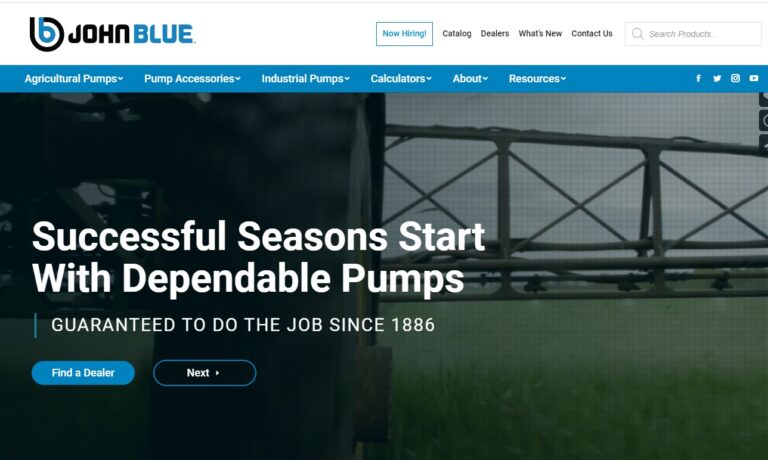
Dewco Controlled Fluid Solutions has been serving industry with fluid metering and control equipment since 1974. With established product lines including metering pumps and solenoid valves among many other products, DEWCO provides quality components for both wholesalers and end users. Our complete system capabilities and repair services mean we can meet your every need quickly and efficiently.
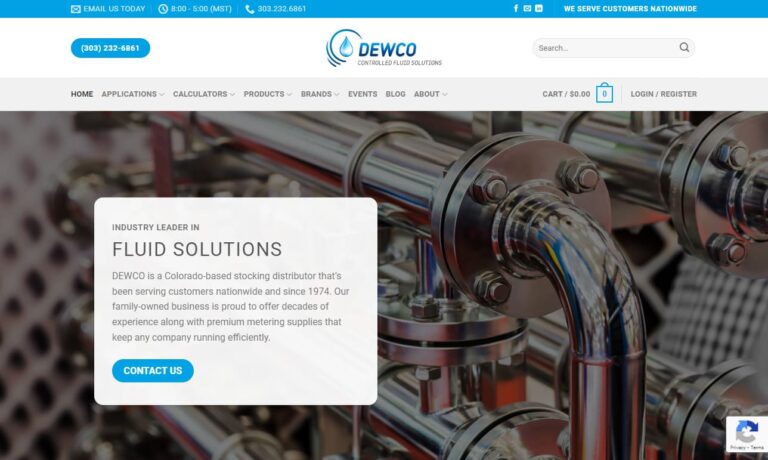
LEWA is your global supplier of metering pumps, process diaphragm pumps and packaged systems. We strive for a close partnership with customers to ensure your complete satisfaction from initial consultation to continuing service and repair, spare parts supply, maintenance and training. A leader in highly precise and high performance pumps, LEWA works with you to find the best component for you.
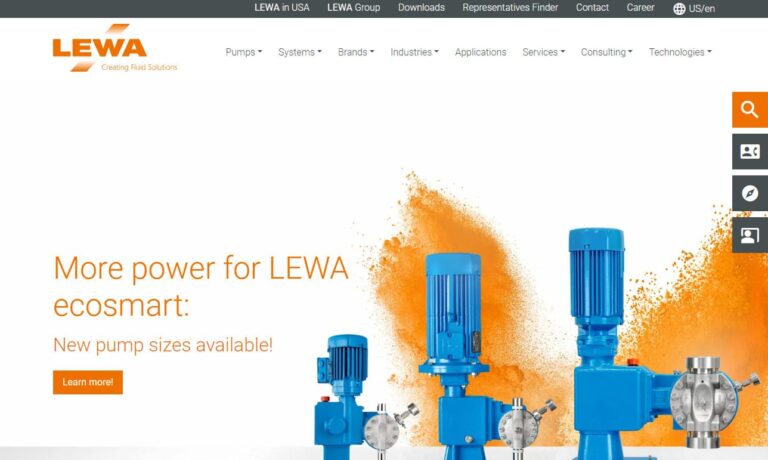
As one of the oldest manufacturers of metering pumps, Randolph has maintained a loyal following by delivering "rugged, reliable and simple to use" products. Randolph machines all the components of its pumps to its exacting specifications and extrudes its own tubing. The Randolph pump can be found working in industries such as printing, food, pharmaceutical, nuclear and wastewater.
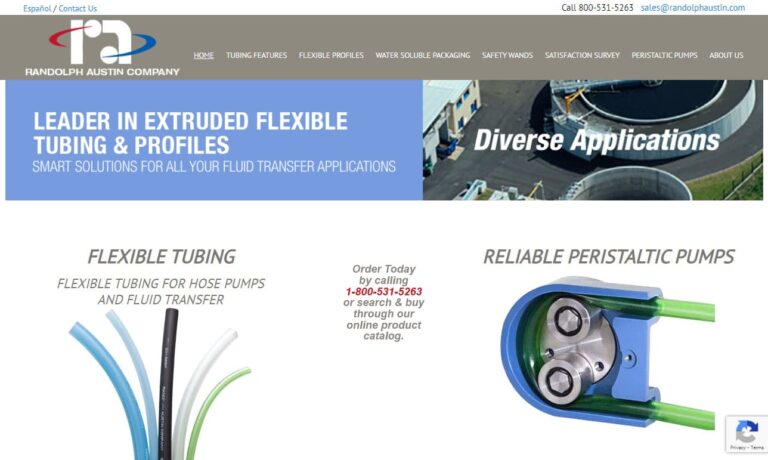
More Metering Pump Manufacturers
Other common names for metering pumps include dispensing pumps, controlled-volume pumps, and proportioning pumps.
Users rely on these pumps in many industries because they produce extraordinarily accurate and repeatable results. They also love them because they send out a liquid cyclically on a consistent basis.
A metering pump is a device used to pump small and accurate amounts of liquid into other fluid streams. The best metering pump is the one that can deliver the liquid in a specified amount of time with an accuracy greater than 3%, in spite of all the discharge pressures. This fluid delivery is called metering, and the metering pumps are also called dosing or proportioning pumps. Many different types of pumps are also called metering pumps, and these can be centrifugal or positive displacement pumps.
Most of the time, metering pumps are used to deliver water, but sometimes they are also used to pump chemicals, solutions, or any other liquids. The rate of pressure that these metering pumps can bear is different, and it depends on the application in which these are being used. Some are able to bear high pressures, while some pumps are not designed in that way. So, it is best to check the type of application before buying a metering pump.
Metering pumps are used for applications related to commercial vending, food and beverage processing, healthcare, irrigation, laboratory research, chemical engineering and processing, metalworking, milling, pharmaceuticals, plastic fabrication, petroleum and gas, water treatment, and more.
History of Metering Pumps
Humans have been using pumps since at least the dominant years of Rome. The Romans, along with the ancient Indians, Persians, and Egyptians, used pumps in water wheels. They used water wheels to convert water power into energy.
Another ancient people that most likely used pumps were the ancient Assyrians. It is likely that they used water screw pumps to irrigate the Hanging Gardens of Babylon. Many historians believe that Archimedes, the Greek polymath, came up with the design for his screw, the Archimedes screw, after visiting there.
During the Dark Ages, technology like this fell into disuse. It wasn’t until the Middle Ages that people began to take a renewed interest in pumps and what they could do. During the Middle Ages, the main thing that made scientists develop pump technology was the mining industry. As it grew in prominence, scientists and engineers looked for ways to make the process more efficient and profitable. That’s when they came up with the piston pump, also known as the suction pump, which works using atmospheric pressure. With early piston pumps, miners were able to force water from inaccessible areas into pump cylinders, then release it elsewhere out of outlet valves, so that they could mine those areas.
During this time, they developed a number of other pumps. One of the best sources on pumps from the 1500s comes from De Re Metallica, a 1556 work by Georgius Agricola.
During the Industrial Revolution, inventors and innovators developed new fluid pumps at a breathtaking pace. They did so in response to the demand put out by new mechanisms such as steam engines. Mainly during this time, manufacturers used pumps to control canal locks and various forms of water flow, though they did not control water flow directly.
In 1936, with the assistance of his father, an American named Robert Sheen invented the metering pump. He sketched and built his earliest pumps in his father’s basement. Sheen and his father, Milton Roy Sheen, worked together at what would later be called GE Water. Together, after selling some of their own products, they ventured out together and founded a company. They called it Milton Roy Pumps. The first metering pumps sold by the Sheens permitted flow rate adjustment but were given to inaccuracies because they permitted leaks. By dividing the pump body into two chambers with a diaphragm, later manufacturers were able to fix this problem. Later manufacturers also improved on the early metering pump by introducing pump materials like PTFE lining, that would not corrode. Early metering pumps used corrosive materials that dirtied the fluid they moved and weakened them.
Gorman-Rupp, a company based out of Ohio, began selling the first bellows type metering pump in the 1970s. Around this time, other manufacturers began producing the earliest diaphragm metering pumps featuring solenoid valves. By adding solenoid valves, engineers made it possible to operate metering pumps using electronics. While these pumps were easier to run, easier to keep healthy, and less costly, they could also operate at high speeds. Sometime later, engineers remedied this issue by implementing CNC dosing control.
Metering pumps that operators use today offer the benefits that come along with advanced technology, like precision, control, and accuracy.
Metering Pump Design
Metering pumps must meet a variety of unique and highly specialized needs, so manufacturers make them available in many sizes, materials, and configurations.
When designing a metering pump, manufacturers must decide on details like the type of liquid in use (fluid composition), maximum discharge pressure rating, flow rates, temperature ratings, motor capacity, and pump apparatus.
They must also decide on whether to build a pump structure that creates and works with variable displacement constant speeds or creates and works with fixed displacement variable speeds. This decision is directly impacted by other details like a pump’s individual motor capacity, stroke length and/or the degree to which the piston, membrane, or bellows can be extended.
Liquid Type
It is important to understand the type of liquid that will flow through a pump for a few different reasons. First of all, most liquids are easy to compress, but if the liquid in use is a type that habitually produces gas bubbles, it will be much harder to compress. Paired with the wrong pump, such liquid may not get dispelled properly or at all. In addition, the type of liquid may affect the material construction of the pump.
Body Material
Generally, metering pumps are made with durable metals, like stainless steel, or durable plastics, like PTFE. Some more than others, however, must have special qualities. For example, chemical metering pumps must be built with materials that exhibit the quality of extreme corrosion resistance.
Construction of Metering Pumps
- The metering pump consists of a pump head and a motor.
- The liquid goes from the pumped head and enters the inlet line.
- The pumped liquid leaves the pump from the outlet line.
- The motor of the metering pump is usually an electric motor.
- Most metering pumps are modified enough that the user can set, adjust, or program the flow rate according to the requirement.
- This programming can be done by touchpad, hand dial, or some other form of control.
Metering Pump Features
No matter the details, all metering pumps are composed of a few important parts, including a pump head, a pump body, a variety of valves, a pumping mechanism, and a motor or engine.
The pump head is a cylindrical cavity, in which fluids reside before they are pumped. So that fluids can flow in and out of it, the pump head has both an inlet and an outlet. Connected to the inlet and outlet are check valves. Attached to the intake check valves are tubes or hoses, which connect it to a fluid reservoir.
The pump’s main body holds the process flow to which the fluid will be introduced. Tubes or hoses connect the outlet, or exhaust, valve on the other end to the main body of the pump. Note that each valve can only flow in one direction.
The pumping mechanism is found inside the pump head and will enact the motion that draws in and expels the fluid. This mechanism may be a piston, diaphragm, or bellows. Depending on a pump’s particular design, attached to this mechanism is either a manual pedal or a motor.
The motor, which drives the pump head as a whole, is usually electric.
How Metering Pumps Work
All pump types operate a little differently than one another, but most still mirror the basic operation of piston pumps. This two-part process begins with the suction, or intake stroke, which is when the piston first leaves the correspondingly shaped chamber in the pump head. When the piston is withdrawn, or, alternatively, when the bellows are extended, a vacuum is created which opens the inlet valve and pulls the fluid into the pump head. When the suction stops, the inlet closes.
After this, an operator or motor extends the membrane piston, or, alternatively, compresses the bellows in towards the fluids. Both actions put pressure on the fluid, in order to compress and pressurize it as much as possible. This pressure forces the outlet valve open, where, due to displacement, the fluid is expelled.
Users generally measure the rate at which a pump expels fluid as gallons per watt-hour, or GPH. GPH is also a reflection of a system’s efficiency.
Specifications of Metering Pumps
Metering pumps are divided on the basis of the mechanism they use to regulate the flow rate. These are:
- A fixed displacement metering pump adjusts the liquid flow according to the speed of the motor. This helps in the consistent flow of liquid with every rotation.
- A variable displacement metering pump adjusts the liquid flow for consistent movement and does not bother the speed of the motor.
Types of Metering Pumps
Variable displacement constant speed pumps are metering pumps that control the amount of liquid being pumped at a time (flow rate) by changing the stroke, or displacement. They can have constant flow rates no matter the engine speed. These metering pumps can produce metered fluid on a continuous basis. Examples of machines that rely on variable displacement constant speed pumps including drink dispenser systems and dialysis machines.
Fixed displacement variable speed pumps adjust flow rate based on motor speed, not stroke. They are simpler than variable displacement speed pumps and cannot transfer as much fluid as them. However, they provide consistent fluid flow rates during each rotation. Most often, people purchase fixed displacement variable speed pumps for use in commercial or industrial settings.
Positive displacement pumps move fluids from high pressure locations to low pressure locations.
Piston pumps use pistons, which are reciprocating, plunger-like cylinders. To pump fluid, they move in and out of a correspondingly shaped chamber in the pump head. The inlet and outlet valves are both connected to this chamber, called the piston chamber.
- It is a positive displacement pump in which a piston is used for liquid displacement.
- The receding of the piston creates a vacuum in the pumping chamber.
- When the chamber is full, it will create a discharge stroke and push the liquid out of the chamber.
Diaphragm metering pumps use a flexible membrane made of Teflon, rubber, or thermoplastic, valves on either side, and, most likely, hydraulic power, to pump liquids. These valves may be any shut-off type that suits the job, such as butterfly valves, check valves, or flap valves. Liquid will not pass through diaphragm pump valves, meaning the liquid inside is sealed off from the outside world. For this reason, customers often choose diaphragm pumps to keep valves from leaking, especially those carrying sensitive, dangerous, toxic, or noxious fluids.
- It is like a piston pump, but a diaphragm works as a piston.
- The movement of the diaphragm creates a vacuum in the chamber.
- The diaphragm then expels the liquid from the chamber.
Bellows pumps work much like piston pumps, except that, in order to generate positive displacement, they use an accordion-style pleated body. Bellows pumps are clean and reliable.
Peristaltic pumps are a lesser known type of pump. Peristaltic pumps use motor-driven rollers to compress and move liquid inside flexible rubber tubing. They work in the same way that a human’s gastrointestinal tract works to move fluids through itself; they contract and relax.
- The peristaltic pump has a hose or tubing for liquid dispensing.
- The fluid control is done by the rollers that are placed on the rotor.
- When the tubing is full, the rotor will rotate and shut off the fluid flow.
- This rotation will help the fluid to move in the pumping direction.
- After this, a negative pressure is created in the tubing once again and will collect more liquid to be pumped.
Pneumatic metering pumps adjust flow rates using pneumatic actuator process signals.
Electronic metering pumps use electrical currents to give power to the actuators that stimulate pumping action. To adjust flow rate, they use electronic actuator signals. Because they are electronic, operators can control them with automated equipment and computer programming.
Micrometer adjustment screw pumps adjust flow rates using micrometer adjustment screws.
Chemical metering pumps are metering pumps designed specifically to move chemicals such as bases, slurries, corrosives, acids, and viscous fluids. Chemical metering pumps may also be called chemical dosing devices.
- Chemical metering pumps are used to deliver chemicals in the fluid.
- Piston and plunger pumps are used for chemical displacement.
- The consistency and accuracy of chemicals are very important in these pumps.
- Too much or too less of the chemical can ruin the pump as well as the application in which it is used.
Fluid transfer pumps, also known as liquid pumps, are any metering pumps that move fluids. This group includes pumps regardless of their power source or flow rate adjustment mechanism. One of the most common types of fluid transfer pump is the water pump.
Dispensing pumps are metering pumps that dispense a predetermined amount of gas or liquid.
Centrifugal pumps move fluid without pulsation or squeezing with the help of a revolving disc.
Drum pumps are metering pumps designed specifically to pull fluids out of cylindrical containers like drums, tanks, and barrels.
Gear pumps move fluid by trapping it in between the teeth of rotating gears. Usually, they use two or three gears at once, and they are magnetically powered. Gear pumps work with applications requiring high pressure.
- Gear metering pumps are used for highly viscous liquids because they can withstand high pressures.
- They have an intermeshing movement of gears that creates a vacuum for fluid dispensation.
- The rotary movement of gears helps the liquid to move from the inlet valve to the outlet valve.
Small metering pumps are miniature pumps; they may be small in size, lightweight, and/or transporters of a particularly low flow. Small metering pumps can transmit fluid with the exact same amount of accuracy and precision of larger metering pumps.
Syringe Metering Pumps
- Syringe metering pumps are used in hospitals because they have a controlled flow rate.
- This metering pump is used to infuse or withdraw the liquid.
- These are not used for automated applications and are very sensitive to pressure changes.
Plunger Metering Pumps
- Plunger metering pumps use a plunger for fluid movement.
- A suction check valve pulls the liquid into the chamber, and the plunger moves forward to push the liquid out of the chamber.
- Plunger pumps can tolerate more pressure and speed than that piston pumps.
Solenoid Metering Pumps
- A solenoid metering pump uses electromagnetic force for its work.
- When it is an electromagnet, it attracts the plunger towards itself and sucks the appropriate amount of liquid.
- The solenoid pumps are easy to operate and have LEDs installed.
- These are simple to operate and control and are highly efficient pumps.
Advantages of Metering Pumps
Metering pumps offer their users many advantages. First, they dispense fluid with high levels of accuracy and control. Second, they can work with harsh or hazardous fluids. Third, they are versatile; they can work with both high-pressure systems and low-pressure systems. Also, users can control them in many different ways, depending on their design.
Metering Pump Accessories
Examples of common metering pump accessories include foot valves, pressure control valves, injection valves, inline pressure relief valves, calibration cylinders, and pulsation dampeners.
Applications of Metering Pumps
- Metering pumps are used in commercial washing machines. Detergent dosing pumps ensure the right amount of detergent in every wash. This prevents machine blockage, and an efficient washing process is achieved.
- Metering pumps are also used in industries for automated dispensing of raw products for packaging.
- Chemical metering pumps are used in water treatment plants. An accurate amount of chemicals are introduced into the water for its purification.
- Chemical metering pumps are also used in the oil and gas industry. These are used to pump chemicals and other gases in the pipelines to prevent corrosion and to get an efficient production rate.
- Metering pumps are also used in irrigation systems to water the fields and crops by sucking water from underground sources such as ponds or rivers.
Metering Pumps Standards
Metering pumps are beholden to a variety of different standard requirements, depending on the industry and location in which they are used. The American military, for example, requires that metering pumps meet Mil-Spec standards. Likewise, metering pumps used in food and beverage or healthcare in the United States must meet FDA standards.
On top of industry and location specific standards, you may want to make sure your metering pumps meet the standard guidelines of one or more organizations in the US or EU, such as ATEX, NEMA, and/or ANSI.
Things to Consider Regarding Metering Pumps
Metering pumps are incredibly useful but can be intimidating to shop for without professional assistance. For the best results, you need to consult with a high-quality metering pump manufacturer. Of course, finding a high-quality metering pump manufacturer can also be intimidating. To help find the right supplier for you, we’ve put together a list of some of those metering pump manufacturers we trust most. You can find their information by scrolling towards the middle of this page.
From among them, find the right manufacturer for you by determining which one offers the services that most closely align with your needs, the best budget for you, the right delivery options (including delivery date), and the overall best customer service attitude.

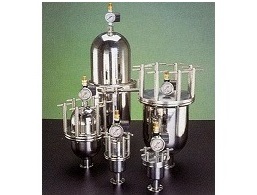
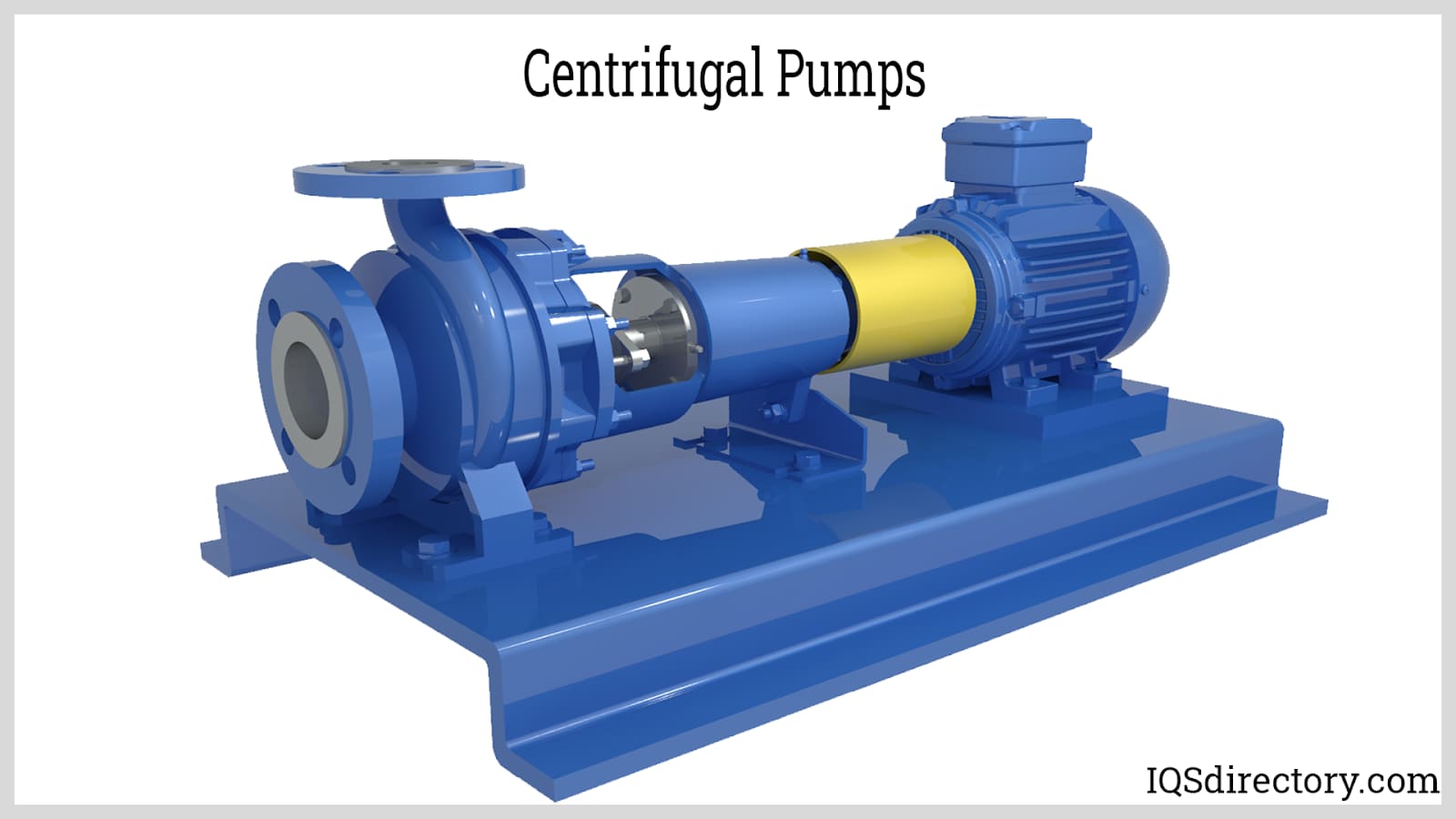
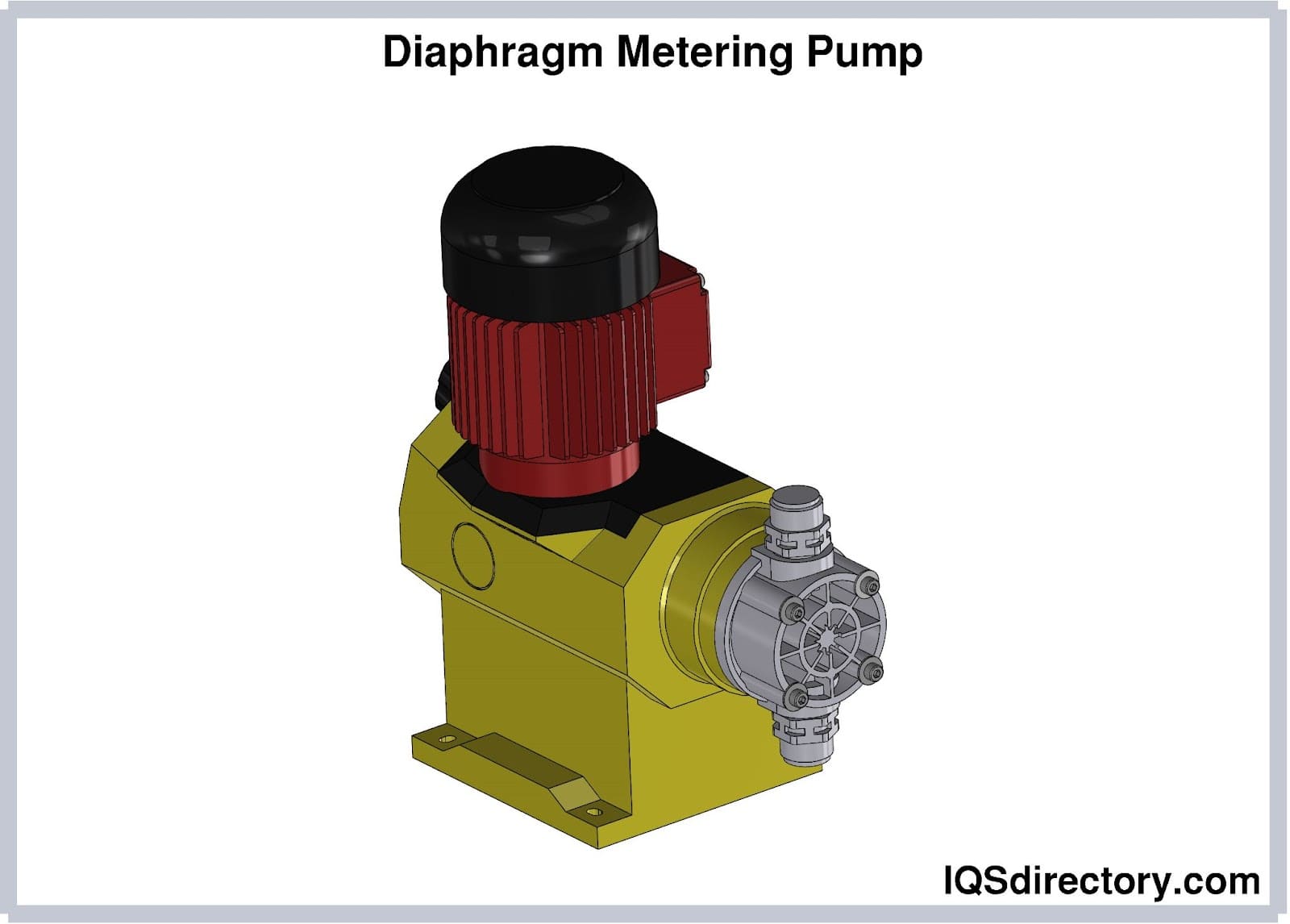
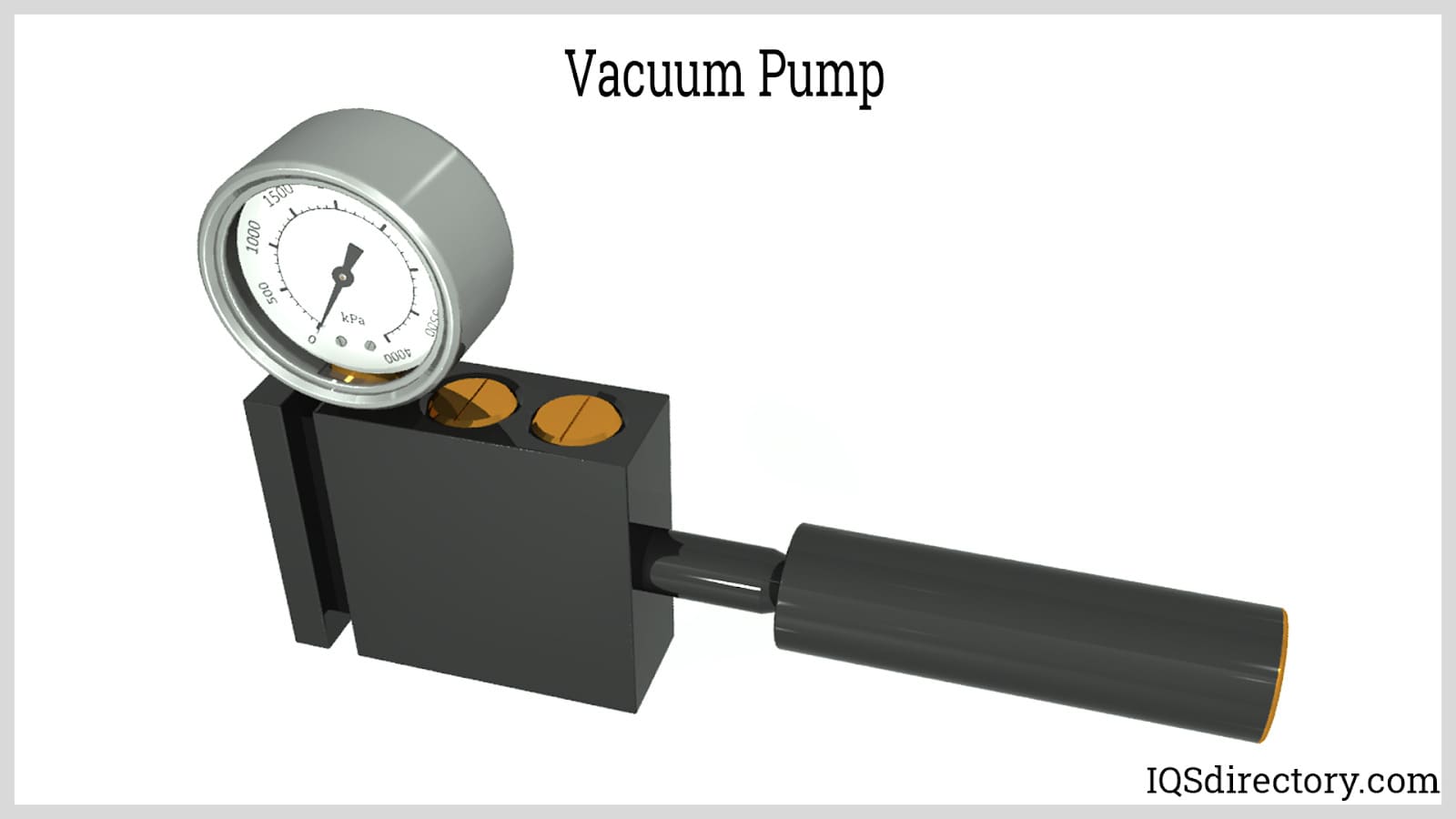
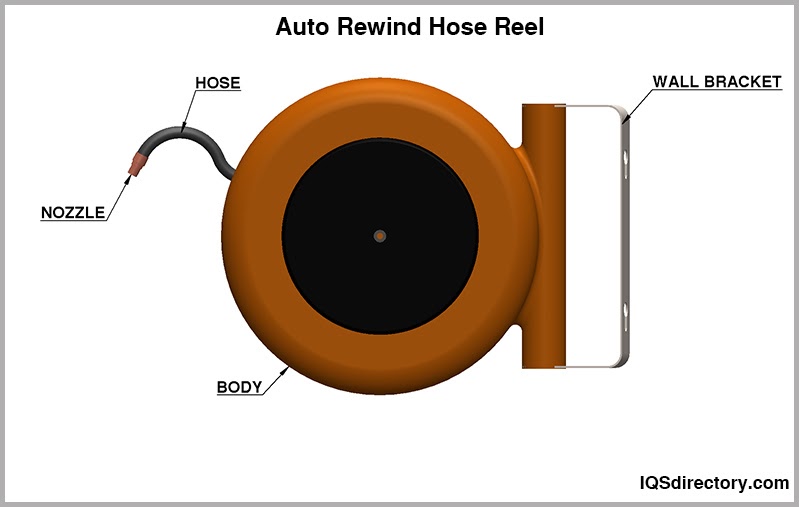


 Flow Gauges
Flow Gauges Flow Indicators
Flow Indicators Flow Meters
Flow Meters Flow Switches
Flow Switches Castings & Forgings
Castings & Forgings Bulk Material Handling
Bulk Material Handling Electrical & Electronic Components
Electrical & Electronic Components Flow Instrumentation
Flow Instrumentation Hardware
Hardware Material Handling Equipment
Material Handling Equipment Metal Cutting Services
Metal Cutting Services Metal Forming Services
Metal Forming Services Metal Suppliers
Metal Suppliers Motion Control Products
Motion Control Products Plant & Facility Equipment
Plant & Facility Equipment Plant & Facility Supplies
Plant & Facility Supplies Plastic Molding Processes
Plastic Molding Processes Pumps & Valves
Pumps & Valves Recycling Equipment
Recycling Equipment Rubber Products & Services
Rubber Products & Services